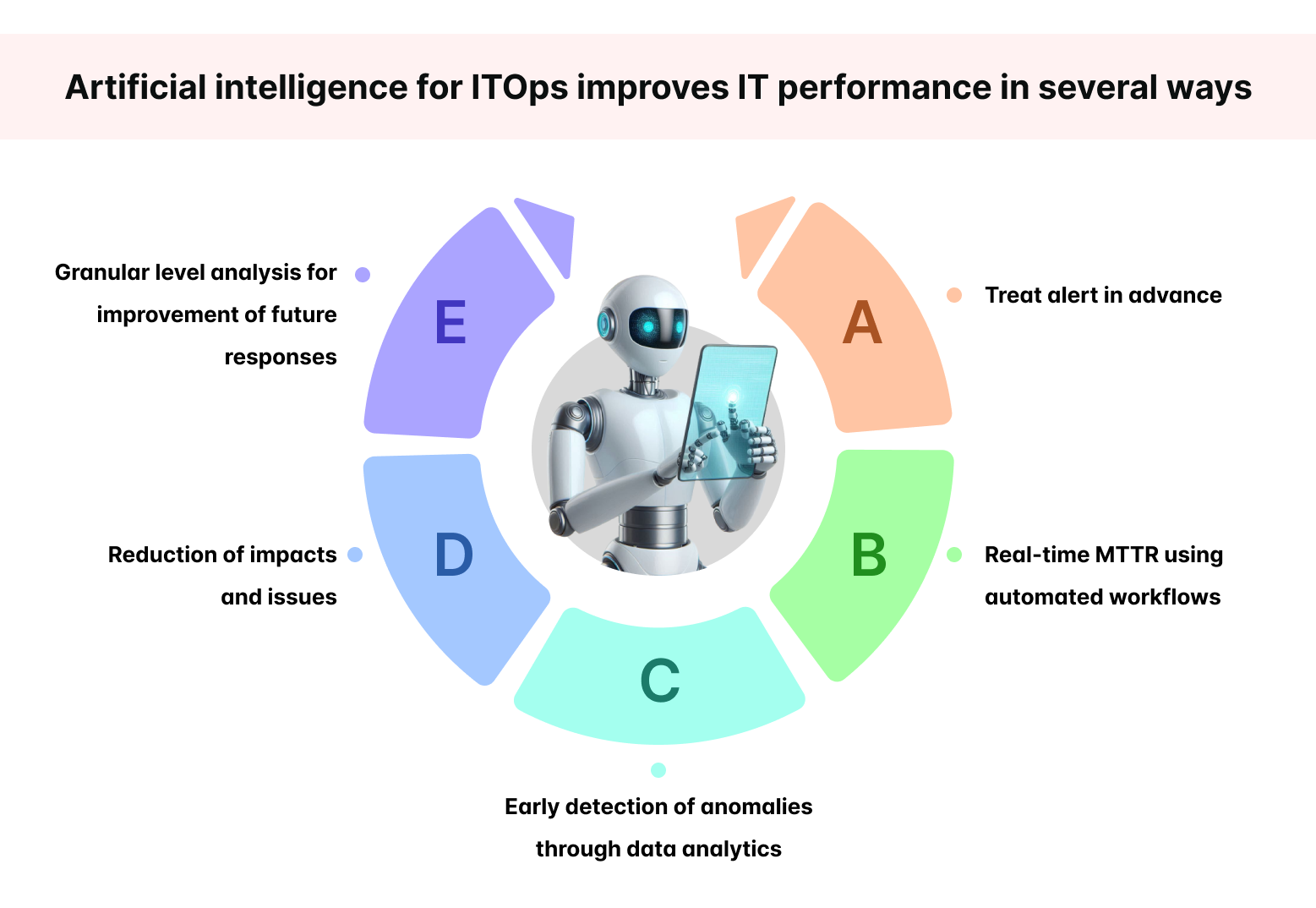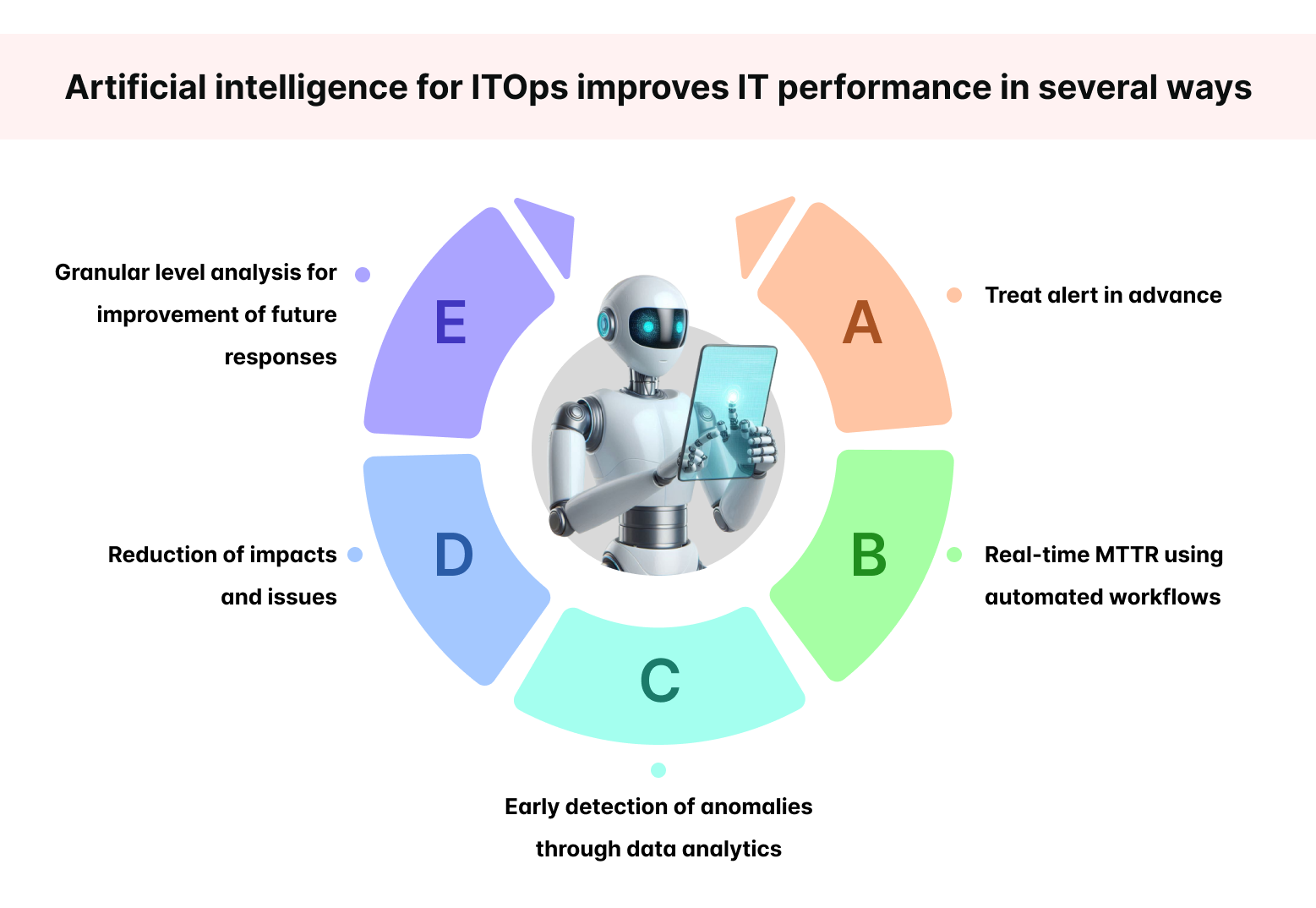IT operations teams, site reliability engineers (SREs), and service providers are on a mission to scale across geographies, expand their digital services, and create new experiences for customers.
Their backend IT systems are becoming more complex amid this endeavor. This makes monitoring and troubleshooting more difficult and limits insight into the apps. Businesses can't afford to lose out on income or customer satisfaction ratings because of problems with their IT stack, like data replication, longer incident response times, and unannounced outages, given the intense competition in the market.
To overcome these challenges AIOps can play a vital role in IT operations to increase automation, enhance security, and significantly reduce downtime. Machine learning (ML) is used by AIOps to improve IT operations such as event correlation, performance monitoring, and analysis. IT teams, SREs, and service providers can anticipate, stop, and automatically fix outages with AIOps.
Moreover, AIOps leverages machine learning (ML) to assess historical and present data to generate accurate forecasts that lower expenses and accelerate return on investment (ROI).
Greater visibility and problem-solving with AIOps:

AI and ML are the key components of AIOps.The identification of the underlying cause and notification of events to the IT operations teams can lower the mean time to repair (MTTR) and mean time to identification (MTTI). Utilizing predictive intelligence, issue assignment can be automated.
For site reliability engineering (SRE), AIOps provide end-to-end visibility. A set of guidelines known as SRE can help engineers apply software engineering concepts to IT operations and infrastructure. This method fosters in-depth system study down to the code level. For example, rather than just debugging the program, engineers aim to find the causative link in the event of an application failure to understand why it occurred. Operations engineers can use AIOps to determine which business service is impacted by an issue.
Predictive analytics and AIOps can assist organizations in identifying and resolving problems before they become more serious. By proactively identifying anomalies and controlling events, AI in AIOps lowers "alert noise" and helps to eliminate the majority of occurrences.
With AIOps, troubleshooting issues becomes simpler. For instance, a sizable food and beverage company used predictive AIOps to correlate insights from telemetrics and logs of application and infrastructure components with alerts on any irregularities during the delivery of their beverage cans. This enabled them to foresee when the problems may arise next and prevent them, which assisted them with speedier triaging.
AIOps can help increase the effectiveness of IT operations by addressing all areas including:
Observation: This includes recording metrics, logs, and traces, observing historic, real-time data, and log data, and tracking service availability
Organization: Putting in place service maps and identifying resource dependency and discovery of infrastructure, cloud, and application to enable simpler resolution of challenges.
Analysis: Alert correlation, root cause analysis, event management, log analytics, dynamics threshold, and anomaly detection can help narrow down any issues.
Management: AIOps enable simpler IT service management, dashboards, orchestration, automation and self-healing, and cloud management
Collaboration: This includes incident response, on-call management, and faster response time.
Benefits of AIOps in predicting and preventing Issues:

An AIOps platform like Onepane may efficiently tackle even the most complex IT difficulties because it integrates automation, observability, and service management into a single cycle. It provides enterprise management integration and optimization, security, dependability, and a great user experience that boosts business profitability.
Analyzing root causes demands significant effort and knowledge of component interactions. Engineers often shift through scattered and uncorrelated logs, metrics, events, and change data. Multiple incidents might stem from a single event affecting a shared component. OnePane simplifies this with its automated discovery module, which maps and connects the underlying communications between components, streamlining root cause analysis.
Example:
Downtime in the financial services sector can have serious repercussions, such as monetary losses and reputational harm. An AIOps platform was deployed by a prominent bank to track its IT infrastructure and anticipate possible problems. To find patterns suggestive of possible failures, the platform examined data from many sources, such as transaction logs and server performance indicators. The bank was able to keep up services, improve customer happiness, and prevent expensive downtime by proactively resolving these concerns.
Proactive Outage Prediction: AIOPs integrate machine learning techniques to conduct data analysis, enabling the early detection of possible outages via predictive analytics.
Better Incident Response: AI algorithms facilitate faster, more precise issue resolution through automated identification and speedy root-cause analysis.
Dynamic Resource Management: To avoid overloads, AIOPs balance network traffic and optimize resource allocation in real time.
Real-Time Data Analysis: To prevent disruptions, real-time data analysis and ongoing monitoring enable well-informed decision-making.
Learning from the Past: AIOPs improve prediction accuracy and support long-term trend analysis for more effective planning by leveraging previous data.
Smart Alerting Systems: AIOPs focus on important concerns for quicker resolution by prioritizing and contextually enhancing notifications.
Conclusion:
The process of implementing AIOps involves ongoing improvement. Collaboration between various IT teams and integration with current tools and procedures are necessary for the successful implementation of AIOps.
By releasing the potential of massive language models to enhance AIOps, generative AI will likely influence the ITOps scene in the future. It will make process automation easier, increase productivity, get rid of tedious chores, and save expenses. The new era of IT operations management is being ushered in by mature businesses that are turning more and more towards AIOps.

